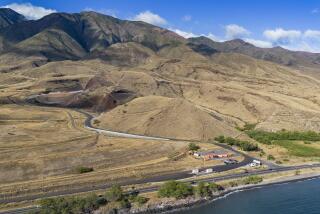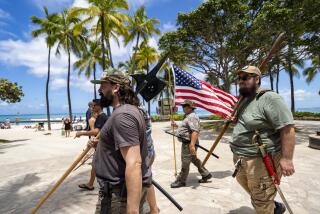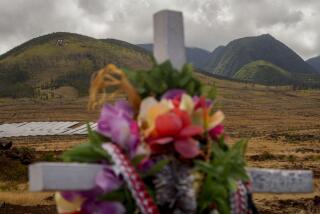Fire Goddess Defended : Harnessing of Volcano Is Hot Hawaii Issue
- Share via
VOLCANOES NATIONAL PARK, Hawaii — In the sulfur sunlight, a woman with orchids in her hair slips beneath the rope barricade and walks barefoot across the jagged black rock to a steaming abyss on the volcano Kilauea.
Soft and low, she begins to chant in Hawaiian, her eyes closed to the uneasy glances of the tourists who have stumbled, this acrid morning, upon her ritual.
The volcano worshiper tenderly places a fern garland on the edge of the eerie black maw, then scuttles away backward, crouching in obeisance to the goddess she knows as Pele.
“Pele is very real to us,” the woman explained later. “She is a living god. You can see her, you can feel her, you can taste her, you can smell her.
“And you can destroy her.”
To many, Pele is merely a colorful island legend, but to an uncountable number of Hawaiians she is a fiery deity, the volcano goddess whose survival now depends on a perplexing First Amendment issue that pits tradition against technology, culture against convention and god against God.
In their defense of Pele, her followers are having to make public a religion that has been personal to the point of secrecy.
What is at issue is an effort to tap geothermal energy from the hissing heart of Kilauea. Proponents think the multimillion-dollar project can someday supply the power to light up the entire chain of oil-dependent islands. Pele worshipers are convinced that it is slowly killing their living goddess and that the volcano’s record five-year eruption is evidence of her anger.
“It is rape,” said Lehua Lopez, a believer who spoke for the Pele Defense Fund. “They are punching holes in what we consider her body. She has eaten 58 houses already. She’s causing people to be sick.
“She’s mad.”
So are her faithful.
Mad enough, in fact, to take Pele’s case not only to the U.S. Supreme Court but to the skeptical public, risking, they believe, both social ridicule and the wrath of the 400,000 Hawaiian spirits they recognize--including Pele herself--as their underground religion emerges for the first time since the Christian missionaries landed here nearly two centuries ago.
And while their religion may be ancient and secretive, their tack is bold and modern. The Pele practitioners are delivering their heaviest blows to Hawaii’s most sacred cow--tourism.
Full-Page Ad Appeal
The Pele Defense Fund raised $35,000 for a full-page ad in the New York Times that outlined religious, economic and environmental objections to the geothermal drilling beneath this bitter invitation: “Come to Hawaii. Swim in polluted water. Breathe toxic fumes. See ugly electric towers.”
When the ad ran last week, Kilauea put on a fireworks display that park rangers described as the most spectacular in more than a year.
“It seems as if she’s taking the case into her own hands, supporting us in our fight for her,” said Emmett Aluli, a physician and American Indian who is vice president of the Pele Defense Fund.
The case has inched its way through the state judicial system over the past five years. Impassioned believers have testified under oath at the hearings and have performed traditional hula dances and chants that tell stories of Pele.
Tom Lubben, an Albuquerque attorney working with the Pele defenders, said that only a handful of worshipers are willing to come forward because of the social stigma attached.
“The new culture made it shameful to acknowledge one is a believer,” Lubben said. “They learned over the years that you don’t succeed and survive and win by being up front about pagan beliefs.”
Thousands of Worshipers
While the geothermal advocates maintain that very few people practice the Pele religion, the Defense Fund estimates the number of worshipers to be in the thousands--ranging from doctors and educators to farmers and fishermen. Money for the ad came from American Indian groups on the mainland as well as from private donors.
The case was submitted to the U.S. Supreme Court in October, but the justices have yet to say whether they will consider it.
Although the site of the planned geothermal plant is privately owned, it falls within a conservation district on the “big island” of Hawaii, so its use is regulated by the state Department of Land and Natural Resources.
To Campbell Estate, the large Honolulu company that owns the 27,000 acres to be leased for geothermal drilling, the Pele issue is a painful one.
“I am a Hawaiian,” explained Campbell Estate’s chief executive officer, Oswald Stender. “We will not challenge their right to worship, but Hawaiians use nature to their benefit. The volcano traditionally has been used for healing, for cooking and worship. I’m saying this is an opportunity to use nature.”
A 5-Year Development
Stender said that the project will not proceed until the Supreme Court acts, but after that, the plant could be operational within three to five years.
Pualani Kanahele, whose hula troupe danced at one hearing, described the volcano goddess as “the only visible . . . life connection we have to the Hawaiian culture . . . And once this steam is cut off from us and taken elsewhere, this part of our culture will die.”
The caldera called Halema’uma’u is known as Pele’s living room and is a favorite spot for leaving offerings of plants and food, but the practitioners maintain that the entire volcano from summit to sea--including the proposed drilling area--is their god, and that the deity is manifest in the steam and lava that Kilauea spouts.
Religious Use Doubted
The Department of Land and Natural Resources acknowledged the faith of the Pele worshipers, but found there was little or no evidence that religious practices take place on the drilling tract. To perform rituals there, however, the worshipers say they would have to trespass.
“All that is hot is Pele,” Aluli said. “Look what happened to the god of water, Kane. You see him in waterfalls and streams, all water,” Aluli said. “(Now) Kane has a meter on him, and that’s what is going to happen to Pele.
“She’s going to be metered and sold.”
At Volcanoes National Park, chief ranger Jim Martin said that dozens of people--Pele believers among them--visit each day for religious purposes.
“You go look at Halema’uma’u and it’s littered with incense, rocks wrapped in ti leaves, pork and other offerings.”
Rangers often come across Pele practitioners at an eruption site in the middle of the night.
“They’ll go right up to the flows and the lava,” he said, “but if you can see they’re Hawaiians, you just back off and leave them alone. They’re not going to walk on lava. They use reasonable caution.”
Even nonbelievers sometimes dread Pele’s temper. Tourists return pilfered volcanic rocks and black sand by the bucketful to Volcanoes National Park’s museum, along with testimonies of the bad luck the souvenirs brought them.
Typical was the lament from one visitor who wrote: “Five years later, 10 car accidents later, two unsuccessful business ventures later and a twice-broken heart later, I admit that the place for the enclosed rock of lava is where it belongs.”
Rocks Taken, Returned
Park rangers return the rocks to the volcano.
“We average six to a dozen packages a day,” said park interpreter John Wise, who operates the visitor center. “Some come by express mail or overnight delivery.
“I even had one pair of shoes returned by somebody who had had bad luck and thought sand might have gotten into them.”
Pele practitioners feel vulnerable not only to their own goddess’s temper, but also to the wrath of rival gods such as the pig god and the lizard god. That is another reason the religion is not usually discussed.
“We weren’t allowed to speak about it for fear of evil spells,” one practitioner confided. Asked to give an example of such a spell, the worshiper paused for a long moment before crying, “I cannot! I’m terrified of it. Nobody talks about the religion.
Old Faith Survives
“Hawaiians are still being prayed to death by other Hawaiians. There was a rivalry between two hula halaus (schools) with enemy gods. Half of the men in one group developed inexplicable pain in their legs on the night before a major performance.”
The worshiper recalled the silence that cloaks Pele in her devoutly Roman Catholic family.
“If the doctor failed and the priest failed, as a last resort Mama would call in the kahuna (spiritual elder). I would hear the whispered chants late at night . . . .”
Lopez, a 39-year-old part Hawaiian who sells real estate, began practicing the Pele religion a year ago after studying the ancient hula, which often tells stories of the goddess through chants and dance.
The greatest misperception, she said, “is that we do sorcery and have human sacrifices . . . that we are not civilized people with a modern god. That we’re pagans, heathens.”
Does Pele Need Help?
Some maintain that Pele will fight her own battle on Kilauea.
Steve Moore, an American Indian-rights attorney who filed the Supreme Court petition, said: “Kilauea began erupting from the day they issued the first (geothermal) permits.
“I spent 10 days on that island, and that island, to me, was alive. I got the distinct feeling that humankind was there only by the good graces of a higher power.”
More to Read
Sign up for Essential California
The most important California stories and recommendations in your inbox every morning.
You may occasionally receive promotional content from the Los Angeles Times.










